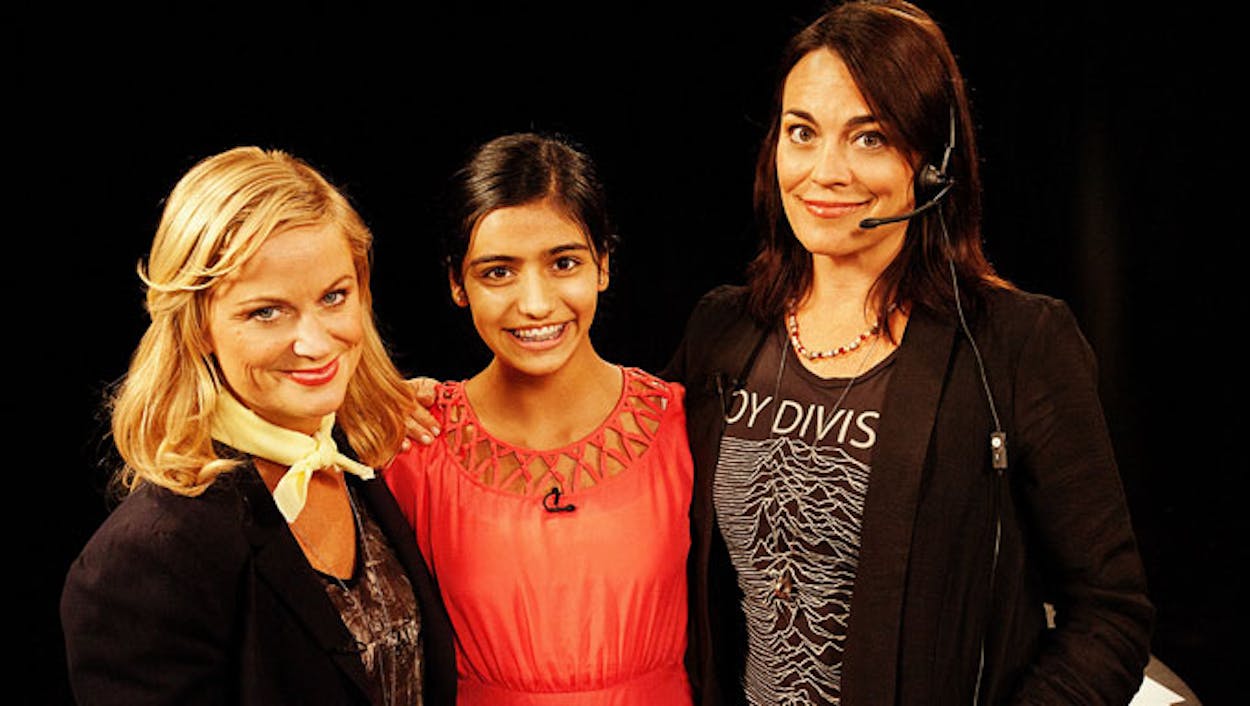On most talk shows with a comedian as host, whether Jimmy Kimmel Live or Late Show With David Letterman, the guests are usually celebrities, who pitch their latest movies and tell lighthearted stories before sliding down the couch to make room for the next A-lister. The few nonfamous people on hand are glimpsed waving from the studio audience or relegated to comic relief in “man on the street” segments.
And then there’s Smart Girls at the Party, an Austin-based Web series hosted by Amy Poehler, who is its co-creator as well as the star of the NBC sitcom Parks and Recreation. Except for the occasional special segment, most of the show’s guests are teenage girls, many drawn from the Austin area, where Meredith Walker, the series producer, lives. Poehler interviews them about their passions, maybe volunteering with the elderly or rescuing abused animals or practicing Sikhism. Each episode ends with an unabashedly dorky, utterly infectious “dance party,” as interviewer, subject and assorted crew members all rock out.
“We wanted to do this celebration of the un-famous, and celebrate how everybody is interesting when they are interested in something,” Poehler said. “Sometimes this thing happens, where people think caring about something is lame. So we wanted to not be afraid of any earnestness.”
The seeds for Smart Girls at the Party were planted after the turn of the millennium, when Poehler and Walker both worked at Saturday Night Live. Walker, who moved to Austin in 2006, said the show was a natural progression from conversations the two women had been having about their own teenage years and about books like Reviving Ophelia, a 1994 study of the pressures that are placed on adolescent girls. With a third friend, the musician Amy Miles, they produced the first season of episodes in 2008 and posted them online.
“It’s almost like that ‘It Gets Better’ campaign,” Walker said, referring to the Web shorts aimed at gay and lesbian youth. “We don’t know anyone who went through adolescence without some bumps in the road. We want to let them know, and show them too, that it gets better.”
Although the series generated an initial burst of publicity in 2008, a long hiatus ensued, as Poehler’s dance card filled with Parks and Recreation and various films and television projects. But in 2012 a deal was struck with YouTube, which agreed to finance a “Smart Girls” channel. A new batch of episodes had their premiere in fall 2012. The offerings were expanded to include segments like “Ask Amy” (in which Poehler answers questions submitted by viewers); “Operation Nice” (which has offered inspirational mini-profiles of a stuntwoman, a triathlete and a ballet company director, among others); and “Boy’s Minute” (where—in a rare nod to actual celebrity—you might find the comedian Aziz Ansari explaining how to take a nap on a couch). Last month, to celebrate Poehler’s birthday, the site introduced a contest in which users were invited to submit photos that illustrated themes like “curiosity” and “the art of living.”
The young women who have appeared on Smart Girls at the Party describe a decidedly un-Hollywood atmosphere on the set of the show. “Amy was super down-to-earth, and she never talked about anything she was working on. The focus was purely on what I was doing,” said eighteen-year-old Mary Bridge, who appeared as a guest last year.
Both Poehler and Walker said that shooting in Austin had helped lend an element of authenticity to the series, allowing them to focus on real girls and real lives, as opposed to Hollywood-based starlets-in-training. Bridge found her way onto Smart Girls after Walker contacted Austin Pets Alive!, the animal rescue organization that Walker volunteers with. Other guests have come from viewer recommendations.
“There’s no real set process, and we like it that way,” Walker said. “We’re really not looking for a super-achiever.”
The show’s YouTube stats have been strong, with more than 90,000 subscribers to the channel and nearly four million overall views. But Poehler is skeptical about the notion that Smart Girls at the Party is yet another example of a renewed cultural focus on young women’s lives, as evidenced by television series like HBO’s Girls and young adult best sellers like John Green’s novel The Fault in Our Stars.
“When you think about those big themes when you are creating something, it kills it,” Poehler said. “There’s nothing worse than saying, ‘I want to make a difference.’ That’s a comedy killer.”
But she does acknowledge that she would be eager to see Smart Girls become something of a household name. The most recent episode of the web series was shot last spring, but Poehler hopes to return to Austin next year to do another batch. In the meantime, Walker is working on building a Smart Girls summer camp, associated with Creative Action, as well as going into partnership with schools to create special events and after-school programs for young women.
“We like the idea that ‘Smart Girls’ is a brand that you feel like you know,” Poehler said. “We want to be like a funny Girl Scouts.”






